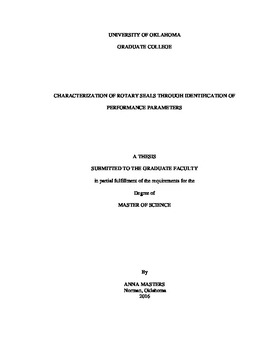| dc.description.abstract | The oil and gas industry is one of the largest industries in the world and is an industry that everyday lives rely on, especially in the United States (U.S.). The constant need for technological advances is more critical than ever in the oil and gas industry. Of the many sectors in the industry, one important sector is the service sector. Service companies develop and maintain a wide range of tools and equipment, such as compressors, valves, and various types of drilling machinery. This research study focuses specifically on rotary drilling equipment. These tools are frequently subjected to a very aggressive and dynamic environment that involves pressure and temperature changes. Harsh operating conditions may cause components within the rotary equipment to fail, which results in costly delays. Identifying and understanding each of the critical components within the rotary system can help prevent future problems. Rotary seals are one such component of rotary equipment that has proven to be susceptible to damage, and therefore will be the focus of this research.
The rotary seal is located directly on the rotating shaft of the equipment; its primary role within the drilling equipment is providing lubrication for the shaft and to protect the mechanical components from the aggressive environment. The aggressive dynamic conditions of downhole drilling can cause these seals to build up friction and eventually fail due to wear and extended dwell periods of sitting idle. The buildup of friction and wear can cause issues such as high torque in both the initial break out torque and during the operational steady state torque. An experimental test set-up was developed to measure rotary seal torque due to changes in operation conditions, such as temperature and rotational speed at constant pressure. The data collected from the experimental set-up was used to identify trends and compared to a theoretical model developed through an understanding of the seal and torque function. The research questions addressed in this Thesis are:
• RQ1: What methods could be used to test and characterize rotary seals?
• RQ2: How to isolate seal torque contribution from the rotary system?
• RQ3: How does seal size, material, temperature, and rotational speed (RPM) effect both break out and steady state torque?
Answering the research questions was accomplished by analyzing the experimental data results. Data analysis revealed an increase in torque as temperature and seal size increased. Higher shaft rotation speeds resulted in lower torque. From literature, a theoretical model from simulations was developed that evaluated contact pressure of the seals on the shaft surface. These calculations were converted to torque values and compared to the experimental steady-state torque data. Similar trends were observed as seal material and temperature changed. Overall the theoretical torque calculation was larger than the experimental steady-state data. This is most likely due to the theoretical model not considering the effect of lubrication.
Future studies will determine how lubrication affects the seal and shaft interaction, as well as examine the performance parameter of leak-rate. The experimental test set-up to address these studies is still being developed. Other studies will also focus on aging effects of seals on performance and the seal service life.
Proper characterization of rotary seals will greatly improve maintenance and serviceability of rotary equipment in the service industry. Through being able to predict the seal behavior, millions of dollars can be saved in repairs and preventing equipment failures. These technology improvements can make the drilling process more efficient, and ensure that energy can always be provided. | en_US |
